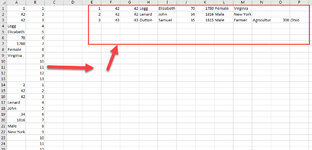Cybermiser
New Member
- Joined
- Sep 15, 2016
- Messages
- 10
- Office Version
- 2016
- Platform
- Windows
Hello,
I'm new to VBA but would like to see if anyone could help me with my VBA code. Attached is a screenshot of the expected result.
Process: I copied column from an online index which has variable number of rows per individual.
In order to transpose the data and align data properly, each set of data "Record" must have the same number of rows.
Rows assigned to a record could range from 8 to 13
Individuals could be alone or part of a family.
Example:
Record #1 - rows 1-9 (9 rows) (that I'll call "Q" through "Z")
Group #42
Record #2 - rows 10-18 (9 rows) (that I'll call "Q2" through "Z2")
Group #42
Record #3 - rows 19-30 (12 rows) (that I'll call "Q3" through "Z3")
Group #43
...etc
If I look at it, I can see that there's a value assigned to each individual, however as well as a "group number" that immediately follows. (ie 1, 42; 2, 42; 3, 43 etc) So that's what I think could be used to determine how many rows to insert.
Data is manually pasted into Column A - no other data present on spreadsheet or workbook.
VBA Code Steps:
Remove the word Close in the last cell
Assign incremental value to each row starting in B1 (assuming that I have to take this step before we can determine how many rows to insert)
Count the number of rows per individual starting with 1 (Originating Cell that I'll call "Q")
If subsequent cell increments by 1 AND the value after it either is the same or increments by one then (Q + 1 (ie "Z"):
Count number of cells between and including Q and Z.
If count = 10 then insert three rows after Z
If count = 9 > insert 4 rows after Z
If count = 13 then go to next set of data
Repeat with next set starting with "Q2"
Thanks for any help!
I'm new to VBA but would like to see if anyone could help me with my VBA code. Attached is a screenshot of the expected result.
Process: I copied column from an online index which has variable number of rows per individual.
In order to transpose the data and align data properly, each set of data "Record" must have the same number of rows.
Rows assigned to a record could range from 8 to 13
Individuals could be alone or part of a family.
Example:
Record #1 - rows 1-9 (9 rows) (that I'll call "Q" through "Z")
Group #42
Record #2 - rows 10-18 (9 rows) (that I'll call "Q2" through "Z2")
Group #42
Record #3 - rows 19-30 (12 rows) (that I'll call "Q3" through "Z3")
Group #43
...etc
If I look at it, I can see that there's a value assigned to each individual, however as well as a "group number" that immediately follows. (ie 1, 42; 2, 42; 3, 43 etc) So that's what I think could be used to determine how many rows to insert.
Data is manually pasted into Column A - no other data present on spreadsheet or workbook.
VBA Code Steps:
Remove the word Close in the last cell
Assign incremental value to each row starting in B1 (assuming that I have to take this step before we can determine how many rows to insert)
Count the number of rows per individual starting with 1 (Originating Cell that I'll call "Q")
If subsequent cell increments by 1 AND the value after it either is the same or increments by one then (Q + 1 (ie "Z"):
Count number of cells between and including Q and Z.
If count = 10 then insert three rows after Z
If count = 9 > insert 4 rows after Z
If count = 13 then go to next set of data
Repeat with next set starting with "Q2"
Thanks for any help!






